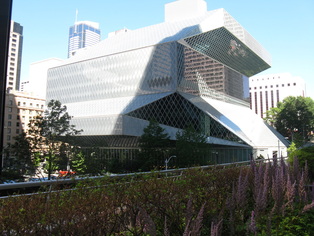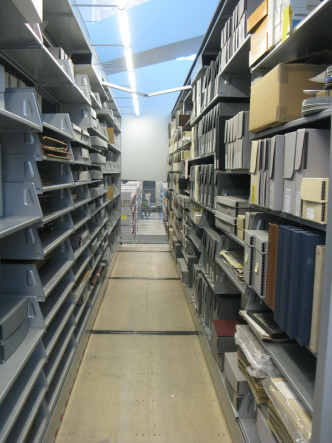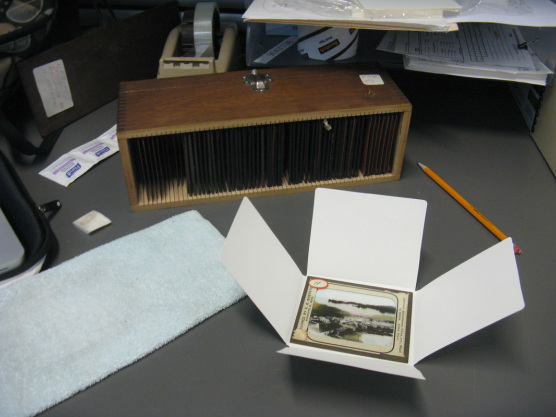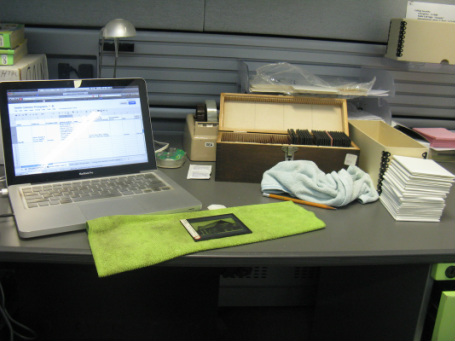Introduction
Working with the Curator of the Seattle Collection at the Seattle Public Library’s (SPL) Special Collections, I researched the photographic collections, assessed their preservation needs, recommended collections or parts of collections for digitization, and prepared a summary of my findings for my summer, 2013 Directed Field Work (DFW).
This page served as my Digital Repository for this DFW as I progressed through my work at SPL.
__________________________________________________________________________
I come to the SPL Seattle Room having been an active patron over several years. I teach the History of Photography at the Photographic Center Northwest and always bring my students to view and experience the seminal works Camera Work by Alfred Stieglitz, et al. and The North American Indian by Edward Curtis. As a photo historian looking for experience in a public library setting, this DFW was a perfect fit as the SPL has several photo collections on which they would like to have work done.
This page served as my Digital Repository for this DFW as I progressed through my work at SPL.
__________________________________________________________________________
I come to the SPL Seattle Room having been an active patron over several years. I teach the History of Photography at the Photographic Center Northwest and always bring my students to view and experience the seminal works Camera Work by Alfred Stieglitz, et al. and The North American Indian by Edward Curtis. As a photo historian looking for experience in a public library setting, this DFW was a perfect fit as the SPL has several photo collections on which they would like to have work done.
June 18, 2013
The first day was one of learning the building, where the lunch room is located and the like. It is a very different experience from working in my little library at Cornish College of the Arts where everyone knows one another. In addition, Ann Ferguson is new to the library as the Curator position is a new one, so she has only been here for a few weeks. We met and discussed the scope of my work and went over the locations of the collections and developed questions to ask Jodee Fenton, longtime Director (need to check her title) of the Special Collections department.
June 25, 2013
Day two began with a meeting in the compact storage on the 9th floor (next to the librarian's offices) with Jodee Fenton, Ann Ferguson, Mike Bergeson and myself. This was an opportunity for all of us to better familiarize ourselves with the photographic collections in the compact storage area. There are collections both on the 10th floor in the Seattle Room as well as on the 9th floor in compact storage. This meeting took most of the morning as was very productive in informing all of us what there is in the collection and what needs more attention.
After lunch, there was a fire alarm and the entire library had to be evacuated. Again, it was fascinating for me to see and experience what it is like to evacuate such a large building filled with the general public and a very large staff. Everything went very smoothly and fortunately it turned out to be a false alarm. After collecting on the lawn of the courthouse to the east of the library and checking in with our respective departments, we were allowed to return to the building. While at Cornish we all simply return at one time (faculty, staff and students), at SPL they had to, of course, only allow the staff in at first in order to prepare the building to receive the general public once again. It was a study in organization and communication that went very smoothly to this observer and the public was allowed back in soon thereafter.
The afternoon was spent beginning to flesh out a spreadsheet that will be used to collect information on the photographic collections. This is a document that will change and grow as the work progresses and we see what information and organizational structure is needed.
After lunch, there was a fire alarm and the entire library had to be evacuated. Again, it was fascinating for me to see and experience what it is like to evacuate such a large building filled with the general public and a very large staff. Everything went very smoothly and fortunately it turned out to be a false alarm. After collecting on the lawn of the courthouse to the east of the library and checking in with our respective departments, we were allowed to return to the building. While at Cornish we all simply return at one time (faculty, staff and students), at SPL they had to, of course, only allow the staff in at first in order to prepare the building to receive the general public once again. It was a study in organization and communication that went very smoothly to this observer and the public was allowed back in soon thereafter.
The afternoon was spent beginning to flesh out a spreadsheet that will be used to collect information on the photographic collections. This is a document that will change and grow as the work progresses and we see what information and organizational structure is needed.
July 9, 2013
The third day was filled with unexpected work: there had been a flood in the Seattle Room the day prior and we spent the day drying out and preserving the affected materials, mostly books and papers from the neighborhoods section of the collection. I met Virginia, who had just been hired to work on the digitization project they are working on and whose first day at work included the flood! She, Jodee and I primarily spent the day assessing, drying, taking inventory, and moving the saturated items to a room where the operations department had set up 2 industrial-sized dehumidifiers and were in the process of dropping the temperature of the room. For most of the day, the temperature was in the 60s while the humidity was in the 40s. These two numbers continued to drop throughout the day and I will see on day 4 how successful our efforts were.
I was struck once again on the differences between the library in which I work and the Central library. Being that it is open to the public, all of those functions had to continue to be fulfilled; when we had a flood at Cornish, it was all hands on deck with everyone in the library helping to cover and protect books, from the Director of Library Services to the workstudy students.
I am looking forward to really delving into the photographic collections! Hopefully I will be able to do that soon. ;-)
I was struck once again on the differences between the library in which I work and the Central library. Being that it is open to the public, all of those functions had to continue to be fulfilled; when we had a flood at Cornish, it was all hands on deck with everyone in the library helping to cover and protect books, from the Director of Library Services to the workstudy students.
I am looking forward to really delving into the photographic collections! Hopefully I will be able to do that soon. ;-)
July 16, 2013
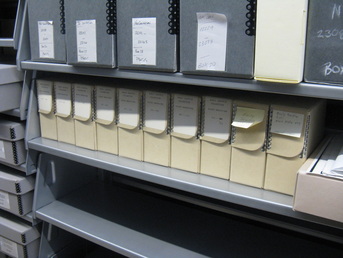 Glass plate negatives, photo by Bridget Nowlin
Glass plate negatives, photo by Bridget Nowlin
Today was filled with cataloging photographs! I worked with the negatives donated to the Seattle Public Library by the Tacoma Public Library from the 1910s. The photos are probably by the photographer Walter Piper. These are glass-plate silver gelatin negatives, mostly 5 x 7" with some 4 x 5"'s. The images are lovely: well composed and exposed, interesting topics in turn of the century Seattle. The library will be digitizing them in order to be able to share them with the public and I know that patrons interested in Seattle history will be very pleased. There are 184 negatives in 11 boxes and they were a pleasure to go through in the 6 hours it took to catalog and prioritize them for digitization.
Jodee, Virginia and I also had a meeting wherein we went over what we had done last Tuesday in regards to the flooding so Jodee could ensure she had all of the facts in hand from the incident. We discussed who did what and how the process might be improved in the future. The books are drying out, and there is some cockling occurring, but at least there does not seem to be any mold growing. Moving them into a room with two industrial dehumidifiers and a cooler temperature certainly helped the situation. It also helped to remove as much water as possible via interleaving paper towels in the books. Hopefully the cockling can be removed with pressing the books.
At the end of the day, I began going through the lantern slides located in wood boxes in the compact storage. The boxes are very delicate and the slides need to be prepared to be moved into archival Metal Edge boxes. I just began the process and it will be interesting to see what I find in the collection. I look forward to making these more available to the public.
Jodee, Virginia and I also had a meeting wherein we went over what we had done last Tuesday in regards to the flooding so Jodee could ensure she had all of the facts in hand from the incident. We discussed who did what and how the process might be improved in the future. The books are drying out, and there is some cockling occurring, but at least there does not seem to be any mold growing. Moving them into a room with two industrial dehumidifiers and a cooler temperature certainly helped the situation. It also helped to remove as much water as possible via interleaving paper towels in the books. Hopefully the cockling can be removed with pressing the books.
At the end of the day, I began going through the lantern slides located in wood boxes in the compact storage. The boxes are very delicate and the slides need to be prepared to be moved into archival Metal Edge boxes. I just began the process and it will be interesting to see what I find in the collection. I look forward to making these more available to the public.
July 30, 2013
The morning included a meeting with Ann Ferguson, my DFW supervisor, to check in with one another and see how my work at the library is coming along. We wrote up my mid-term report for the UW and submitted it and feel that my work here is coming along nicely. I am learning more about how collections operate in a public library while simultaneously I am able to delve deep into some of their photographic collections.
Today was spent working with the Lantern Slides that are in Special Collections. They are currently in wooden boxes that are coming apart. The slides are in dire need of new boxes. The SPL has some beautiful Metal Edge boxes for them along with archival sleeves so each image can be sleeved separately. I am working through the boxes and am cleaning, evaluating, researching when necessary, as well as recommending images for digitization.
In making my recommendations, I am looking at condition, subject matter, quality of the image itself, and composition. I am looking for items that will fit their Neighborhoods project they are currently working on as well as those that are unusual or depict an interesting aspect of their content. For example, there are many photographs in the glass negative collection I worked with last time that depict the photographer's family. Several of these images are gorgeous photographs of the clothing and culture of the time, are very interesting visually, and are good quality photographs in terms of composition, exposure, focus and the like. I am thinking about the possible interests of the public and what might intrigue them and cause them to want to delve deeper into the collections.
Today was spent working with the Lantern Slides that are in Special Collections. They are currently in wooden boxes that are coming apart. The slides are in dire need of new boxes. The SPL has some beautiful Metal Edge boxes for them along with archival sleeves so each image can be sleeved separately. I am working through the boxes and am cleaning, evaluating, researching when necessary, as well as recommending images for digitization.
In making my recommendations, I am looking at condition, subject matter, quality of the image itself, and composition. I am looking for items that will fit their Neighborhoods project they are currently working on as well as those that are unusual or depict an interesting aspect of their content. For example, there are many photographs in the glass negative collection I worked with last time that depict the photographer's family. Several of these images are gorgeous photographs of the clothing and culture of the time, are very interesting visually, and are good quality photographs in terms of composition, exposure, focus and the like. I am thinking about the possible interests of the public and what might intrigue them and cause them to want to delve deeper into the collections.
August 6, 2013
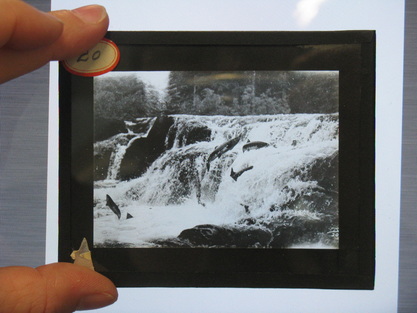 Salmon jumping in Alaska, c. 1909, photographer unknown. photo by Bridget Nowlin
Salmon jumping in Alaska, c. 1909, photographer unknown. photo by Bridget Nowlin
This day was filled with lantern slides from Alaska! These images are from the late 1800s and early 1900s and depict miners, hunters, glaciers, reindeer, walruses, sluice mining, panning for gold and a lovely hand-colored image of salmon spawning. I continue to clean, assess, and prioritize images for digitization and wrap the glass slides in archival folders made for lantern slides. There were more that had damage in this box, so I noted this for future users. I created a spreadsheet with 22 areas that I am looking at when working with the images, both in this collection and other photo collections at the library.
The librarian in charge of digitization and I spoke briefly about the project and will meet next time I am in to discuss in greater detail what should be done on terms of digitization. I also met with Ann to further prioritize my remaining time in Special Collections. It is amazing to think there are only 2 more visits left! I am on track with the photo project, but I simply love my Tuesdays in Special Collections and wish I could continue my work there. I find the work to be of great interest and I often think about the access I am enabling for users of all kinds, both now and in the future. I come from a museum background where access means something very different than that in a public library and I am excited by this difference.
The librarian in charge of digitization and I spoke briefly about the project and will meet next time I am in to discuss in greater detail what should be done on terms of digitization. I also met with Ann to further prioritize my remaining time in Special Collections. It is amazing to think there are only 2 more visits left! I am on track with the photo project, but I simply love my Tuesdays in Special Collections and wish I could continue my work there. I find the work to be of great interest and I often think about the access I am enabling for users of all kinds, both now and in the future. I come from a museum background where access means something very different than that in a public library and I am excited by this difference.
August 13, 2013
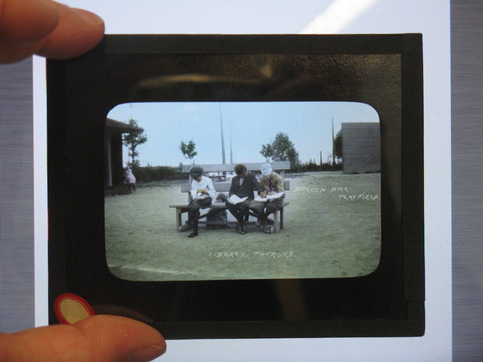 "Library Patrons, Beacon Hill Play Field," c. 1900s photographer unknown. photo by Bridget Nowlin
"Library Patrons, Beacon Hill Play Field," c. 1900s photographer unknown. photo by Bridget Nowlin
I will be able to complete the work with the lantern slides by the time my DFW ends at SPL. The boxes they are currently in are not in good shape and this will enable the staff to better access the slides and make them available to patrons. The datasheet is fleshed out and test scans were done on the lantern slides. Given that the film emulsion is in between 2 pieces of glass, I was concerned about the ability of the in-house scanner to properly focus on the image rather than on the glass itself. The scan worked beautifully. In addition I was able to share the datasheet with the cataloger and the digitization manager so they will be able to better utilize the information in their areas. I have been entering the data I am organizing into a spreadsheet in order to facilitate the uploading of particular fields into other programs such as COntentDM or into a MARC record, as appropriate. This spreadsheet can be accessed below.
The office is one large communal area, so conversations are held in public. This allowed me to listen in while the digitization manager was discussing the digitization project with his new assistant and afforded me some insight to the needs and approaches from a public library point of view.
Ann and I were able to meet to go over the data I have organized on the collections and clarify a few holes in the fields. I had hoped to be able to do more with the other collections, but there is only so much time. I believe I was able to make some of the collections more accessible and usable and I am happy with that.
The office is one large communal area, so conversations are held in public. This allowed me to listen in while the digitization manager was discussing the digitization project with his new assistant and afforded me some insight to the needs and approaches from a public library point of view.
Ann and I were able to meet to go over the data I have organized on the collections and clarify a few holes in the fields. I had hoped to be able to do more with the other collections, but there is only so much time. I believe I was able to make some of the collections more accessible and usable and I am happy with that.
August 20, 2013
Last Day. This is a place and people I will miss greatly. I looked forward to my Tuesdays at the Seattle Public Library and enjoyed my work there thoroughly. Jodee Fenton, the Director of Special Collections commended me on my ability to put my head down and concentrate on my work; the staff gave me going away gifts of SPL swag and a lovely card; I hugged Ann and we expressed our mutual joy of working together.
This last day was filled with tying up loose ends, ensuring that Ann was well aware of the work that I had done so it can be continued where I left it, and getting the last box of wooden lantern slides completed. The photographic collections at SPL are larger than I previously thought and there is a great deal more work that can be done to make more accessible to the public. They are making this happen on a daily basis and are very enthusiastic about their work. As mentioned previously, they are in the process of a large digitization push and the photographs are a priority in this project.
One of the large lessons I am taking away from my experience at SPL is their commitment to serving the public and sharing the collections. Coming from a museological background, I am accustomed to and trained in the preservation of objects, to the point of storing them away and not allowing them to be seen or touched in some cases. In the Seattle Room, the objects are to be shared, studied, wondered over, and enrich the lives of those who come to study there.
This last day was filled with tying up loose ends, ensuring that Ann was well aware of the work that I had done so it can be continued where I left it, and getting the last box of wooden lantern slides completed. The photographic collections at SPL are larger than I previously thought and there is a great deal more work that can be done to make more accessible to the public. They are making this happen on a daily basis and are very enthusiastic about their work. As mentioned previously, they are in the process of a large digitization push and the photographs are a priority in this project.
One of the large lessons I am taking away from my experience at SPL is their commitment to serving the public and sharing the collections. Coming from a museological background, I am accustomed to and trained in the preservation of objects, to the point of storing them away and not allowing them to be seen or touched in some cases. In the Seattle Room, the objects are to be shared, studied, wondered over, and enrich the lives of those who come to study there.
Below are two documents I created in the process of this DFW. I made the primary document in Excel in order that data from certain fields can be uploaded as appropriate by the SPL staff. The second document is a collection of useful information.
| seattle_collection_photographs.xlsx | |
| File Size: | 24 kb |
| File Type: | xlsx |
| useful_websites_and_books_for_the_care_and_feeding_of_photo_collections.docx | |
| File Size: | 6 kb |
| File Type: | docx |
